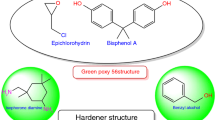Abstract
The shrinkage of fly ash geopolymers was studied in the present study. Fly ash was used as the source material for making the geopolymers. The effects of the concentration of NaOH, sodium silicate-to-NaOH ratio, liquid-to-ash ratio, curing temperature, and curing time on shrinkage were investigated. The geopolymers were cured at 25, 40, and 60°C, respectively. The results indicate that the shrinkage of geopolymers is strongly dependent on curing temperature and liquid-to-ash ratio. The increase in shrinkage is associated with the low strength development of geopolymers. It is also found that NaOH concentration and sodium silicate-to-NaOH ratio also affect the shrinkage of geopolymers but to a lesser extent.
Similar content being viewed by others
References
V.D. Glukhovsky, Soil Silicates (in Russian), Gosstroyizdat Ukrainy Publishing, Kiev, 1959.
J. Davidovits, Geopolymer chemistry and properties, [in] J. Davidovits and J. Orlinski eds., Proceedings of the 1st International Conference on Geopolymer’88, France, 1988, p.25.
D. Khale and R. Chaudhary, Mechanism of geopolymerization and factors influencing its development: A review, J. Mater. Sci., 42(2007), p.729.
P. Chindaprasirt, T. Chareerat, and V. Sirivivatnanon, Workability and strength of coarse high calcium fly ash geopolymer, Cem. Concr. Compos., 29(2008), p.224.
D.L.Y. Kong, J.G. Sanjayan, and K. Sagoe-Crentsil, Comparative performance of geopolymers made with metakaolin and fly ash after exposure to elevated temperatures, Cem. Concr. Res., 37(2007), p.1583.
A. Sathonsaowaphak, P. Chindaprasirt, and K. Pimraksa, Workability and strength of lignite bottom ash geopolymer mortar, J. Hazard. Mater., 168(2009), p.44.
S. Detphan and P. Chindaprasirt, Preparation of fly ash and rice husk as geopolymer, Int. J. Miner. Metall. Mater., 16(2009), p.720.
J.S.G. Van Jaarsveld, J.S.J. Van Deventer, and G.C. Lukey, The characterisation of source materials in fly ash-based geopolymers, Mater. Lett., 57(2003), p.1272.
A. Buchwald, M. Vicent, R. Kriegel, C. Kaps, M. Monzó, and A. Barba, Geopolymeric binders with different fine fillers-phase transformations at high temperatures, Appl. Clay Sci., 46(2009), p.190.
ASTM C109/C109M-02, Standard Test Method for Compressive Strength of Hydraulic Cement Mortars (Using 2-in. or [50-mm] Cube Specimens, ASTM International, 2002.
ASTM C490/C490M-09, Standard Practice for Use of Apparatus for the Determination of Length Change of Hardened Cement Paste, Mortar, and Concrete, ASTM International, 1997.
F. Puertas, S. Martínez-Ramírez, S. Alonso, and T. Vázquez, and Alkali-activated fly ash/slag cements: strength behaviour and hydration products, Cem. Concr. Res., 30(2000), p.1625.
A. Palomo and J.I. López dela Fuente, Alkali-activated cementitious materials: alternative matrices for the immobilisation of hazardous wastes—Part I. Stabilisation of boron, Cem. Concr. Res., 33(2003), p.281.
A. Palomo and M. Palacios, Alkali-activated cementitious materials: alternative matrices for the immobilisation of hazardous wastes—Part II. Stabilisation of chromium and lead, Cem. Concr. Res., 33(2003), p.289.
D.L.Y. Kong and J.G. Sanjayan, Damage behavior of geopolymer composites exposed to elevated temperatures, Cem. Concr. Compos., 30(2008), p.986.
K. Sagoe-Crentsil and L. Weng, Dissolution processes, hydrolysis and condensation reactions during geopolymer synthesis: Part II. High Si/Al ratio systems, J. Mater. Sci., 42(2007), p.3007.
P. Chindaprasirt, C. Jaturapitakkul, W. Chalee, and U. Rattanasak, Comparative study on the characteristics of fly ash and bottom ash geopolymers, Waste Manage., 29(2009), p.539.
T. Bakharev, Thermal behaviour of geopolymers prepared using class F fly ash and elevated temperature curing, Cem. Concr. Res., 36(2006), No.6, p.1134.
Author information
Authors and Affiliations
Corresponding author
Additional information
This work was supported by the Thailand Research Fund through the Royal Golden Jubilee Ph.D. Program (No.PHD/0120/2549).
Rights and permissions
About this article
Cite this article
Ridtirud, C., Chindaprasirt, P. & Pimraksa, K. Factors affecting the shrinkage of fly ash geopolymers. Int J Miner Metall Mater 18, 100–104 (2011). https://doi.org/10.1007/s12613-011-0407-z
Received:
Revised:
Accepted:
Published:
Issue Date:
DOI: https://doi.org/10.1007/s12613-011-0407-z




